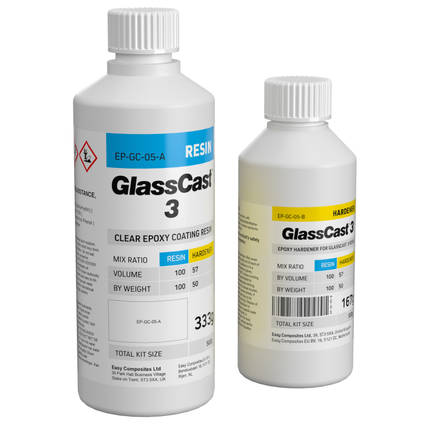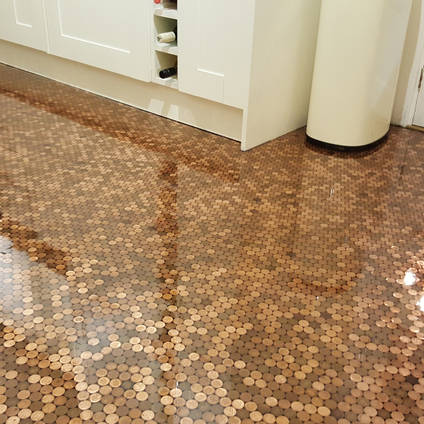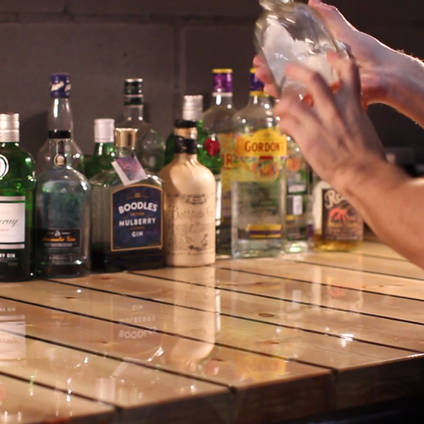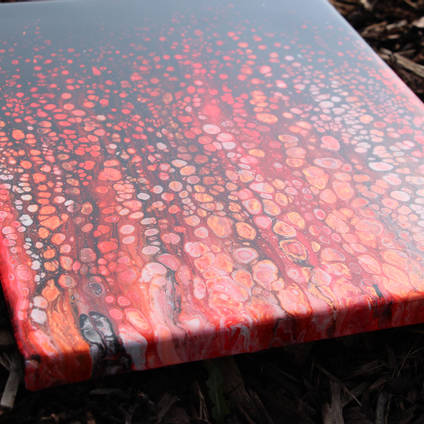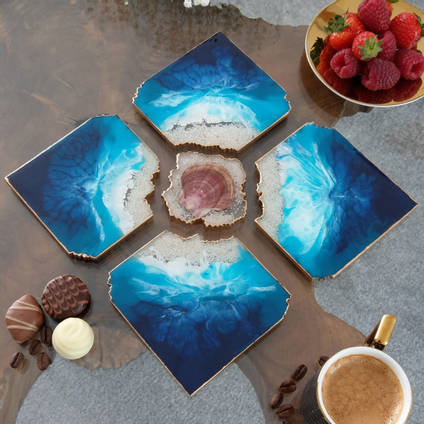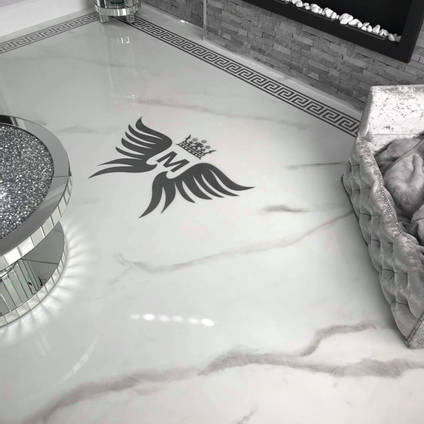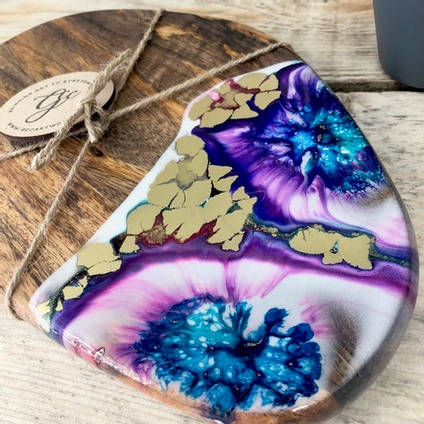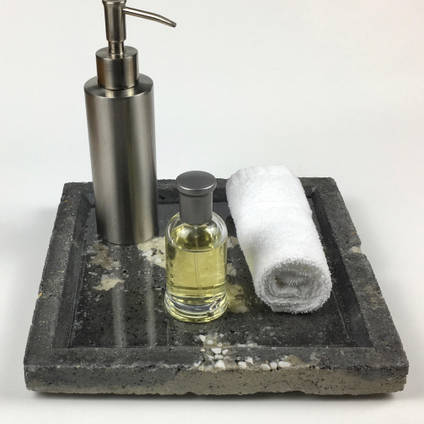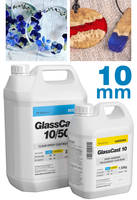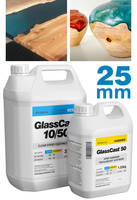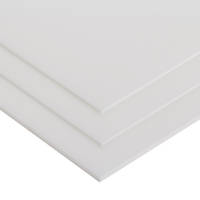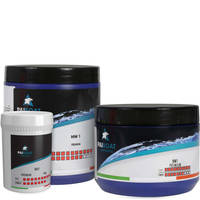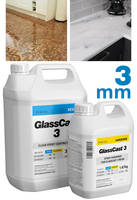Need any help or advice?+44 (0)1782 450300
Downloads (7)
| Safety Datasheet (SDS) - NL | ||
| Safety Datasheet (SDS) - EN | ||
| Technical Datasheet (TDS) | ||
| Resin Countertop Handbook | ||
| Resin Plank Table Handbook | ||
| Penny Floor Handbook | ||
| Resin Plank Table Handbook |
Shipping Information
Restrictions
This product is not classed as dangerous goods for transport and can be shipped to all destinations without restriction.
Shipping to EU countries is now done through our European subsidiary based in the Netherlands. All EU customers should use www.easycomposites.eu.
Package Size
There are no package size restrictions or surcharges for this product.
Delivery Cost
To find the delivery cost of this item to your address, add it to your basket and then use the instant shipping calculator on the basket page.
GlassCast 3 Clear Epoxy Coating Resin - 500g
- GlassCast®
- 4.5/5 Average rating
GlassCast 3 is a clear, two-part epoxy resin designed to add glossy, hard-wearing, self-levelling coatings to floors, counters, furniture and more. The recommended pour thickness for GlassCast 3 is 3mm.
GlassCast 3 can be left clear or pigmented with a wide range of pigments and metallic effects and is our recommended resin for penny floors, kitchen countertops, glossy bartops and resin coasters.
Sold as a kit, including resin and hardener. Available in 500g, 1kg, 5kg, 15kg and 30kg kit sizes.
PRODUCT VERSIONS
Kit Size
AVAILABILITY:More than 20 availablefor immediate shipping
We won’t be beaten on price!
If you believe you’re buying an equivalent product cheaper elsewhere, contact us to discuss your requirements.
GlassCast 3 is the world-famous clear epoxy coating resin used to create stunning glossy coatings on existing floors, decorative floors, artwork, bar-tops, counter-tops and furniture. GlassCast 3 is easy-to-use, hard-wearing, self-levelling and has excellent UV resistance.
Choose GlassCast 3 for any project where a relatively thin but flat, glossy surface is the most important requirement. This is because GlassCast 3 uses special additives which keep the surface of the resin super-flat and glossy, however these additives start to affect the clarity of the resin once it's more than around 5mm thick making it the perfect resin for floors.
GlassCast 3 Recommended Uses
- Penny Floors
- Decorative floors (adding pigments and metallic powders)
- Bartops and kitchen worktops (with or without pigments and effects)
- Resin-art (adding pigments, tints and other effects)
- Furniture (such as resin plank tables)
- Agate coasters
- Artwork and Resin Art (coating art, photography and more)
GlassCast 3 Advantages
GlassCast 3 has been developed to be as easy to use and reliable as possible. Special additives used in the resin mean the cured surface is as flat and glossy as possible, unbeaten by any other resin on the market. GlassCast 3 professional resin also uses advanced resin technology to expel trapped air-bubbles whilst it cures, meaning that jobs where a heat-gun or blowtorch can't be used - such as a large floor - can still be completed with glorious bubble-free resin.
To prevent yellowing or discolouration, GlassCast 3 uses an industry leading UV resistant formulation which ensures that it will continue to look fantastic for years to come. Even so, GlassCast resins are only recommended for indoor applications.
Once fully cured, GlassCast 3 is incredibly hard-wearing, similar to the toughness of epoxies used in warehouse or industrial flooring! If the resin does eventually start to get marked by daily use, it can be polished back up to a mirror finish using specialist polishing compounds.
- Very clear with incredible flat, glossy surface finish
- Easy-to-use, self-releases trapped air bubbles
- Highly UV resistant
- 12 months shelf life
- Very tough and scratch-resistant
- Trusted by thousands of users worldwide!
Outdoor Use
Despite the very good advanced 'UV' resistant formulation of our Glass Cast resins, we don't suggest using the GlassCast range of resins for permanent, outdoor applications. This is down to epoxy chemistry meaning that eventually, over time, depending on UV exposure, environmental conditions etc, the resins will always eventually yellow in outdoor conditions. How visible this is depends on factors such as the underlying colour and conditions experienced.
We simply don’t have the longevity of testing to be able to guarantee how long it will be before the resin may start to deteriorate in direct sunlight, adverse weather conditions (freezing in winter, high temps in summer), water pooling or sitting on top, etc. We have got customers who have used it for such applications but the advice would be to either put the outdoor projects away between uses or to have a cover to protect it if no other product (yacht varnish, etc.) would suit your project.
Ambient Temperature, Pot-Life and Pour Depth
The GlassCast range of resins, in common with all epoxies, generate heat as part of the curing process. The amount of time the mixed resin can spend in the pot, as well as the maximum depth it can be poured at, will vary depending on the ambient temperature.
For best results, we recommend working in a consistent room temperature of 18-20°C. GlassCast can be used in temperatures from 15 to 25°C but higher temperatures will reduce the pot-life and the maximum pour-depth of the resin significantly, as shown in the table below.
| Ambient Temperature | 15°C (minimum) | 20°C (minimum) | 25°C (minimum) |
|---|---|---|---|
| Maximum Time in Pot (Pot Life) | 45 mins | 30 mins | 22 mins |
| Maximum Pour Depth | 9mm | 6mm | 3mm |
| Initial Cure | 36 hrs | 24 hrs | 18 hrs |
How to Use
GlassCast 3 has been developed for professional users to produce the best results possible. It is not a 'craft' product and not intended for children. Before purchase, storage or use you must read the safety and technical data. Having said that, GlassCast 3 is incredibly easy-to-use and delivers fantastic results under a wide range of conditions.
GlassCast 3 is sold as a kit which includes both the resin and hardener. Take a look at our Resin Calculator to work out how much GlassCast you need for your project. When you are ready to pour, measure the resin and hardener at the correct ratio and mix thoroughly. Add any pigments or effects and then pour the resin - no more than about 5mm deep - onto your prepared floor, surface or artwork. The resin will reach initial cure in around 24hrs.
Download the Technical Datasheet from the 'Downloads' tab for full details on correct measuring, mixing and use of the product.
Getting More Creative - Pigments, Tints and Metallics
Although GlassCast 3 is often used completely clear - over existing flooring or a wooden table-top, for example - it is also compatible with our complete range of tints, pigments and metallic-effect powders. Many other colours and powders can be added too but be sure to conduct a test to ensure compatibility.
- Metallic effect SHIMR powders for swirling, sparkling colour
- CULR epoxy colour pigments for see-through to opaque in a wide range of colours
- Pinata alcohol inks for vibrant, translucent colour
If you are looking for a casting resin rather than a coating resin our GlassCast 10 or GlassCast 50 will be more suitable.
GlassCast 3 is the world-famous clear epoxy coating resin used to create stunning glossy coatings on existing floors, decorative floors, artwork, bar-tops, counter-tops and furniture. GlassCast 3 is easy-to-use, hard-wearing, self-levelling and has excellent UV resistance.
Choose GlassCast 3 for any project where a relatively thin but flat, glossy surface is the most important requirement. This is because GlassCast 3 uses special additives which keep the surface of the resin super-flat and glossy, however these additives start to affect the clarity of the resin once it's more than around 5mm thick making it the perfect resin for floors.
GlassCast 3 Recommended Uses
- Penny Floors
- Decorative floors (adding pigments and metallic powders)
- Bartops and kitchen worktops (with or without pigments and effects)
- Resin-art (adding pigments, tints and other effects)
- Furniture (such as resin plank tables)
- Agate coasters
- Artwork and Resin Art (coating art, photography and more)
GlassCast 3 Advantages
GlassCast 3 has been developed to be as easy to use and reliable as possible. Special additives used in the resin mean the cured surface is as flat and glossy as possible, unbeaten by any other resin on the market. GlassCast 3 professional resin also uses advanced resin technology to expel trapped air-bubbles whilst it cures, meaning that jobs where a heat-gun or blowtorch can't be used - such as a large floor - can still be completed with glorious bubble-free resin.
To prevent yellowing or discolouration, GlassCast 3 uses an industry leading UV resistant formulation which ensures that it will continue to look fantastic for years to come. Even so, GlassCast resins are only recommended for indoor applications.
Once fully cured, GlassCast 3 is incredibly hard-wearing, similar to the toughness of epoxies used in warehouse or industrial flooring! If the resin does eventually start to get marked by daily use, it can be polished back up to a mirror finish using specialist polishing compounds.
- Very clear with incredible flat, glossy surface finish
- Easy-to-use, self-releases trapped air bubbles
- Highly UV resistant
- 12 months shelf life
- Very tough and scratch-resistant
- Trusted by thousands of users worldwide!
Outdoor Use
Despite the very good advanced 'UV' resistant formulation of our Glass Cast resins, we don't suggest using the GlassCast range of resins for permanent, outdoor applications. This is down to epoxy chemistry meaning that eventually, over time, depending on UV exposure, environmental conditions etc, the resins will always eventually yellow in outdoor conditions. How visible this is depends on factors such as the underlying colour and conditions experienced.
We simply don’t have the longevity of testing to be able to guarantee how long it will be before the resin may start to deteriorate in direct sunlight, adverse weather conditions (freezing in winter, high temps in summer), water pooling or sitting on top, etc. We have got customers who have used it for such applications but the advice would be to either put the outdoor projects away between uses or to have a cover to protect it if no other product (yacht varnish, etc.) would suit your project.
Ambient Temperature, Pot-Life and Pour Depth
The GlassCast range of resins, in common with all epoxies, generate heat as part of the curing process. The amount of time the mixed resin can spend in the pot, as well as the maximum depth it can be poured at, will vary depending on the ambient temperature.
For best results, we recommend working in a consistent room temperature of 18-20°C. GlassCast can be used in temperatures from 15 to 25°C but higher temperatures will reduce the pot-life and the maximum pour-depth of the resin significantly, as shown in the table below.
| Ambient Temperature | 15°C (minimum) | 20°C (minimum) | 25°C (minimum) |
|---|---|---|---|
| Maximum Time in Pot (Pot Life) | 45 mins | 30 mins | 22 mins |
| Maximum Pour Depth | 9mm | 6mm | 3mm |
| Initial Cure | 36 hrs | 24 hrs | 18 hrs |
How to Use
GlassCast 3 has been developed for professional users to produce the best results possible. It is not a 'craft' product and not intended for children. Before purchase, storage or use you must read the safety and technical data. Having said that, GlassCast 3 is incredibly easy-to-use and delivers fantastic results under a wide range of conditions.
GlassCast 3 is sold as a kit which includes both the resin and hardener. Take a look at our Resin Calculator to work out how much GlassCast you need for your project. When you are ready to pour, measure the resin and hardener at the correct ratio and mix thoroughly. Add any pigments or effects and then pour the resin - no more than about 5mm deep - onto your prepared floor, surface or artwork. The resin will reach initial cure in around 24hrs.
Download the Technical Datasheet from the 'Downloads' tab for full details on correct measuring, mixing and use of the product.
Getting More Creative - Pigments, Tints and Metallics
Although GlassCast 3 is often used completely clear - over existing flooring or a wooden table-top, for example - it is also compatible with our complete range of tints, pigments and metallic-effect powders. Many other colours and powders can be added too but be sure to conduct a test to ensure compatibility.
- Metallic effect SHIMR powders for swirling, sparkling colour
- CULR epoxy colour pigments for see-through to opaque in a wide range of colours
- Pinata alcohol inks for vibrant, translucent colour
If you are looking for a casting resin rather than a coating resin our GlassCast 10 or GlassCast 50 will be more suitable.
Any mild soap and detergents will be fine for cleaning GlassCast Resin. Try to avoid strong acids or bases or neat cleaning products as it is possible they may dull the surface finish.
The GlassCast range of products are not designed for permanent outdoor use. Although the GlassCast resins have a very high level of UV resistance, the very high levels of UV exposure and the variety of inclement weather and environmental conditions experienced mean that the resin would degrade if permanently used outdoors.
Certainly, we can sell the resin and hardener separately if you need extra of either one one its own. Although not listed on the website we can do this over the phone or you can email us and we can send you an invoice with the correct amounts on it. The hardener for each of the GlassCast products is unique for that product. Using hardeners from other resin systems will cause serious curing issues or it may not cure at all.
Hi Nicole, this would slightly depend on how you'll be making up that total depth. Generally speaking, flower preservation castings are done in at least 2 pours often more. At the very least, the first pour is usually used to provide a clear 'shelf' on which to position the flow so that it appears suspended in the final casting.
If you're doing multiple pours on a casting that will be a total of 7cm thick then it will probably mean that no single pour exceeds the 50mm maximum (per pour) for GlassCast 50 (when pouring into a mould) and so you could use GlassCast 50.
If you wanted to do the whole depth (50mm or more) in a single pour however then you would need to choose the GlassCast 50 PLUS. 50 PLUS allows you to cast up to 100mm (into a mould) in a single pour with a lower risk of the resin over-heating during its cure. This makes it great for big/deep castings and would make it a good choice for 50-70mm flower preservations but the trade off is that it does mean that it takes a lot longer to cure; around 7 days compared to 48hrs for GlassCast 50.
Yes, you can do an oven post cure of the coasters. The reason a post cure is helpful is that epoxy resins like these have a very long tail end of the cure when cured only room temperature. This means that over several weeks, the properties of the resin - including heat resistance - will develop as the resin cures fully. Typically after 7 days most of the resin is cured, however the post cure process will improve on that further as well as speeding up the process.
To do the post cure, you need access to an oven which has a reasonably accurate temperature control. The actual post cure cycle is to initially cure the resin for 24 hours at room temperature, followed by curing in the oven at 60° for 16 hours. Once allowed to cool to room temperature, the coasters will then be ready for use. Doing this post cure will give a heat distortion temperature of around 55 - 58°C which means you even less likely to get rings or marks from hot cups or plates.
If you are unable to get access to an oven for post curing, the resin does still perform well after allowing the resin a full 7 day cure at room temperature. Following a full 7 day cure, a very subtle ring may still be left by leaving an extremely hot cup to stand on the surface of the resin, this mark is slight and can usually only be seen if the surface reflection is inspected closely. Customers who use this resin for drinks coasters report that the marking is almost un-noticeable in practical applications and continue to use GlassCast commercially for coaster applications.
The amount of resin needed is slightly different depending on if the bottle tops/pennies have been grouted level or not. For Penny Floors we always recommend grouting the floor as it seals the pennies in and helps provide a smoother overall finish to the floor. For other objects such as bottle tops, it may not always be practical to use grout.
If the floor has been grouted, you will need 2kg of resin per square meter coverage. This will give a layer approximately 2mm thick over the bottle tops/pennies.
For un-grouted floors, you will need 3kg of resin per square meter to be covered. Again, this will give a layer approximately 2mm thick over the bottle tops. The extra kilo of resin is to fill all the gaps surrounding the bottle tops.
Grouting between penny's and other embedded items is not necessary and doing so is usually down to personal preference. In terms of which type and brand of grout, any grout is fine although semi-flexible grouts might be preferable if there is any movement in the floor at all.
In all cases, you must ensure that the grout is fully dried before you apply the resin as excess moisture can cause resins to go cloudy and in extreme cases may effect the cure.
You need roughly 2716 one pence coins per square meter of floor. If you go for 2 pence coins instead, 1750 two pence coins are needed for every square metre of area. That is based on them being tightly configured together. Other patterns may need a different amount.
Yes, you can make a floor from GlassCast in a kitchen or bathroom. As both environments can be quite humid (and also subject to spillages in use), it's essential to ensure the room is fully dried out before applying the resin and, most importantly, allow the resin to *fully* cure before using it again, especially if it's likely to get wet. Even in a warm environment, you should leave the floor for at least several days before use.
Yes the resin can be drilled into/through without any difficulties, although it's worth pointing out that it doesn't hold a thread very well, in case that's what you are intending to do.
If you have some GlassCast left over from another project, then yes, there is no reason why you couldn’t brush apply it onto the worktop to waterproof it; however, in a brush coat, it might be very slow curing and you’d need to be sure that the temperature was kept up throughout to ensure it fully cured.
If you were buying an epoxy resin specifically for the project, I would suggest the XCR coating resin as a better option as it is faster curing (within a few hours) and still clear in thin coats. Either option will gain the same end result but the GlassCast3 will take much longer to cure.
We don’t specifically measure it but we do specify residual chlorine content (in the form of hydrolysable chlorine) in our raw epoxy materials (note, this is not free “pure” chlorine, which is not present). These are typically 300-500ppm in quantity.
No, not specifically although it does depend on what your substrate (the material you're pouring the GlassCast onto) is made from and what condition it's in.
For non-porous surfaces, like a laminate worktop, we wouldn't suggest any priming, just key the surface with abrasive paper to allow the resin to bond properly. Same with other non-porous surfaces like metal. For plastics, it's worth checking whether the resin will be able to bond properly to the plastic, some plastics are easy to bond to, others are almost impossible.
For porous surfaces like wood or MDF then we recommend using an application of GlassCast (mixed as normal with its hardener) as a primer/sealer coat. This will soak into the wood and stop it from breathing. Once cured, the surface should be keyed (with abrasive paper) and then you're ready to go, GlassCast can be poured onto this surface without fear of the wood/MDF swelling or breathing out air bubbles into the thicker resin coating.
Yes, you can certainly use GlassCast 3 on a round glass top table. One particular consideration though would be how well the resin would bond to the glass, given that glass is very smooth and shiny. If you thoroughly degreased the glass then you might find that you can get a sufficiently good bond just straight on to the glass without any need to 'key' the glass. However, it is possible that the resin would struggle to make a strong bond to the shiny glass, in which case you would need to 'key' the (i.e. scratch it up) using some abrasive paper. Given the extra work of keying it, it might be worth doing a small test on un-keyed glass first.
As for the edges, you have 3 options:
- You could just allow the resin to flow over the edges, this method is simple but only allows you to build up about a 1mm thick coating.
- You could using some tape like our Resin Barrier/Release Tape to tape around the edge of the table, leaving an upstanding amount of tape which would retain the resin. If you do this, you can have a much thicker coating of resin but you will end up with a slight 'meniscus' of resin where it meets the tape which would need sanding away and polishing.
- You could use some masking tape around the edge of the table as a temporary barrier and then when the resin is slightly cured (about 1-2 hours) you can remove the tape, allowing some resin to flow over the edge but leaving most still on top. This is the method we use for the edges of countertops. Please take a look at our Complete Epoxy Resin Countertop Tutorial in our Videos & Guides section for more information on this.
As long as you reseal the bottles promptly after use and store them in accordance with the datasheet, then we would expect you to still achieve the full 12 months shelf life.
This rather depends on the type and condition of the varnish that's been used. If the varnish feels soft or greasy at all then it might not make a suitable substrate for the resin, in which case you would need to scrape or sand it away. If the varnish feels dry and hard then it's likely to be fine but it would certainly need 'keying' with coarse abrasive paper to provide a suitable surface for the GlassCast to bond to. If in doubt, it might be worth conducting a small test to check how well the GlassCast bonds to the keyed varnish.
...would i be able to sand and use a satin lacquer as a final coat or will it fail?
Lacquers and clear coats are quite soft compared to the GlassCast epoxy and so it would be a shame to use such a relatively soft finish as the bartop surface. However, it's actually perfectly achievable to lightly sand the GlassCast 3 finish using a fine abrasive paper (such as an 800 or 1000 grit) to give the resin a satin finish. The finer the paper, the smoother and less matte the finish will become; you can choose how far you go according to how satin/glossy the customer wants. If you take a look at the video we did for the GlassCast 50 river table video, you can see the appearance of 1200 abrasive paper before we switch to polishing compound - this should give you a good idea of what you could achieve on the GlassCast 3.
I want to use GlassCast on a bathroom floor with a slight slope so any excess water would flow to the drain in the corner. How would that work - would I be able to apply even coat on the surface or would GlassCast flow to the lowest area?
GlassCast is self levelling which means it will try and flow to the lowest point of the room and level out, this means that it's very difficult to use the product on a sloped floor such as a shower or wet-room. You may be able to build up thin brush-applied coats but - because it won't be flowing and self-levelling as it normally would - you would need to flat and polish the brushed finish in order to achieve the normal perfectly flat gloss finish.
Newspapers and most papers can be covered and sealed in with the resin. However, you may need to seal the paper itself first. The reason is because some lower grade and thinner papers will go translucent when saturated with a liquid, including resin. I would recommend doing a small test piece to check. If you need to seal the paper, then the best method is to brush a thin coat of PVA wood glue over the paper and allow to dry. The PVA glue will cure clear and seal the paper from the resin meaning you can coat the project and get the desired effect.
Regarding general suitability of the resin for a dining table, GlassCast 3 is a hard wearing surface and so not unsuitable for this purpose but do bear in mind that hot objects (such as hot plates) would mark the surface and so you would need to use mats to protect the resin from anything hot.
The best kind of materials to go for are generally inert plastics such aspolypropylene sheet , polyethylene and PTFE. This is because epoxy resin does not naturally stick to these plastics and as such no release agent is needed.
Yes, GlassCast can be machined and cut using a variety of powertools and equipment - including a router - no problem. We would recommend an initial cure period of 48 hours to allow sufficient hardening prior to any machining work.
The scratches left from keying the surface of the resin will be filled in with the fresh layer of resin and, as long as the surface was properly cleaned, will be invisible once the new layer of resin cures.
We would not envisage any problems with GlassCast ® being used on a typical Conservatory floor as the temperature is unlikely to get above the HDT of 45 °C. If the floor surface temperature did reach in excess of 45-50°C it is possible it may soften and therefore potentially be damaged - although realistically the floor would be too hot to walk on at this point.
One point to note during pouring of GlassCast is to pay special attention to ensuring that the temperature of the floor is as close to, or above, 20°C as possible throughout the cure. Some conservatory's are not insulated to the same standard as the main house and can be considerably cooler than expected.
Yes, from the testing that we've done it does seem possible to use acrylic (spray) paints to colour GlassCast although our suggested method for colouring GlassCast would still be to use our fully compatible CULR pigments and SHIMR powders.
If you do want to use a spray paint to pigment GlassCast then you should test a small area/amount first just to confirm that it works with your actual paint type and quantity.
Although GlassCast has very good UV resistance, it is still affected by UV light to some extent and as such is not recommended for outdoor use due to continuous high levels of UV exposure and also continuous exposure to moisture and adverse weather conditions.
However, if the table is brought indoors after use, then the reduced UV exposure would considerably improve the lifespan before yellowing may begin to occur.
If the material you will be pouring GlassCast 3 over is porous such as wood, chipboard or MDF then it is highly recommended to apply a sealing coat before the main pour. Doing so will improve the flatness of the final surface and help to eliminate warping of the substrate after cure.
Mix around 500g of GlassCast per square metre of surface you need to seal. Don’t worry if most of the resin seems to be absorbed by the substrate; this is normal for the sealing coat. Allow this sealing coat to cure before proceeding to the main pour. Depending on the ambient temperature, this is likely to take around 24 - 48hrs. For very porous substrates (like MDF) you might need to lightly flat the resin coated MDF to remove any 'high spots' where MDF fibres have swollen and created a coarse surface.
The best product would definitely be this one, the GlassCast 3. This resin will provide a really smooth, shiny, hard-wearing finish to the tiles. One important thing you need to be aware of would be the heat stability of any epoxy, including this one, would not really make it suitable for HOT drinks as they could leave a small mark in the resin.
This is however true of all resin coatings, even those which claim to be high temperature suitable; they will - unfortunately - all still mark to some extent.
The best kind of materials to go for are generally inert plastics such as polypropylene, polyethylene, nylon and PTFE. This is because they do not naturally stick to epoxy resin and as such no release agent is needed
Yes... and no. GlassCast is capable of resurfacing a worktop in a kitchen no problem. With proper preparation, the end result should look amazing however it's important to consider the limitations of a resin coated work surface.
Generally kitchen work tops are subject to high levels of wear and tear which will in time may scratch and dull the surface finish of the GlassCast surface but this sort of wear and tear can usually be polished out to restore the finish.
The main consideration for a resin coated kitchen worktop is temperature, especially hot pans/plates etc. which would certainly mark the surface if they're placed directly onto it. As a result, you will need to use pot stands/trivets to prevent excess heat being conducted into the resin.
GlassCast is a great product to fill cracks and knots in wood as well as filling gaps between 'waney edge' reclaimed timbers, including colouring the resins with pigments.
Other than the practicality of reduced access during the application, there is no reason why in theory you could not use GlassCast on a staircase. Depending on the shape of the stair edge, you would need to build barriers to keep the resin contained during the pour. Once cured, the edge can be sanded and shaped as desired.
Be aware that GlassCast (and all polished smooth surfaces) can be very slippy, especially in socks or when wet which could be quite hazardous on a flight of stairs. Finally, staircases can be particularly high-traffic areas because they concentrate all footfall into a small area and therefore the accumulation of scratches and general wear on the surface could occur faster on stair treads.
Although GlassCast has very good UV resistance, it is still affected by UV light to some extent and as such is not recommended for outdoor use due to continuous high levels of UV exposure and also continuous exposure to moisture and adverse weather conditions.
Instead we would suggest a specialist 'driveway' resin designed for outdoor although we don't stock this type of resin ourselves.
For very large floor areas we would recommend limiting the maximum amount mixed in one go to 5kg batches. That way you can sensibly weigh each part accurately and the volume is not too large to be able to mix by hand thoroughly. Mix each batch thoroughly then pour it into a second larger bucket before mixing again and pouring on the floor. You need to work quickly and pour from the second bucket as soon as possible to avoid the resin exotherming in the bucket.
When using this method on larger floors, the long pot-life means you should have enough time to mix up the resin into the large bucket and pour it with plenty of time left. As you are mixing several batches and pouring in one session, there will be no issues of joins between resin batches.
Although epoxies in general are inert once fully cured, GlassCast has not been tested or certified as food safe and as such we cannot recommend its use in situations where a food safe resin is needed.
If food-safe certification is critical to what you're doing then it might be worth considering a product like ArtResin.
Due to its low viscosity (runny) nature, it would be impractical to cast GlassCast onto vertical surfaces such as walls, so we would not recommend its use in such circumstances.
However, a solution would be to make flat panels on a flat surface using GlassCast and once cured, the finished panels can be mounted on a vertical surface.
As you have suggested, the only realistic method to produce a splashback or wall hanging display of this type is to produce it on a flat surface then mount it once dry. Good quality marine grade ply or similar should be suitable to lay the bottle tops/coins on. You can build a temporary dam around the outside edge for resin pouring them remove it to shape and finish the final product.
In general, once fully cured, water splashes should not cause any problems with the resin. The biggest concern is heat when being used as a kitchen splash back. GlassCast does not have a very high heat resistance with it being designed to operate permanently at up to 45 °C which means high levels of direct heat could damage the surface. There is a risk that hot oil or food splatter may leave a slight surface mark, however this should be able to be polished out.
In theory you do not need to bond down the pennies because the resin will flow under the pennies and bond them down at the same time. The coins are heavy enough to stay in place and will not float as long as you are careful pouring the resin. However in practice a lot of people like to bond them down to create patterns, ensure alignment and so they don't move while they work their way around the floor.
Bottle tops are best bonded into place, as being lighter, they are more prone to floating and moving around. A technique that can work quite well with bottle tops is to pour a very thin layer of mixed resin onto the surface, then manually place the bottle tops into the resin. The working time will be around 30-40 minutes to place the bottle tops onto the surface, so this method is more suited for smaller projects or you could mix and spread small batches at a time, ensuring you're staying within the gel time of each resin application.
Alternatively many DIY adhesives are likely to be suitable and may be easier to work with. In rare circumstance you may encounter an incompatibility so we would always suggest making up a test tile using the exact floor, pennies (etc.) and adhesive and then pouring the GlassCast on the sample. You can then check every part of the process before starting the main project - this is very important to ensure there are no unforseen problems with compatibility or your process.
GlassCast will bond fine to ceramic and porcelain tiles. The surface will need to be thoroughly cleaned, degreased and be free of loose debris and dirt to achieve the best bond.
Where tiled floors are not perfectly even, as long as the lips and tile edges are not too high, the resin will flow over the edge and the whole surface. Use a spreader to help initially spread the resin over the floor, then leave it to settle down and self-level.
Yes our GlassCast will work with glitter type materials. Without bonding it down, the glitter could potentially move around and float in the resin. A simple solution would be to use a thin layer of PVA wood glue as an adhesive or even a thin layer of the GlassCast itself. Paint on the glue (or resin), sprinkle on the glitter and allow to dry/cure. You would then shake or lightly brush off the loose glitter before doing the main pour of GlassCast.
Yes, as long as the surface has been given a good key with sandpaper and a thorough clean then there should be no problem applying GlassCast over a varnished surface.
Uncured or tacky patches of GlassCast are normally as a result of only a handful of occurrences, before suggesting a solution, it is important to identify the cause.
- Epoxy resin needs to remain at around 20°C + for the entire curing time. If the temperature is much below 20°C, it will stall the cure and could give rise to potential problems so keep the room nice and warm before and during pouring the resin. Worktops tend to be much colder than you imagine so I would recommend warming up the cabin before you pour the resin to make sure the worktop is up to temperature and also keep your resins in doors before use so they're at room temperature before mixing. 20°C is 68°F.
- The resin has a very specific mix ratio of 2:1 by weight. This means that you need to be accurate with your mix, and in essence for every 200g of resin, you need to mix in 100g of hardener – this does need to be weighed and not worked out by volume. If you're pouring the full contents of the containers out and mixing them together, that won’t be an issue as we weigh the two parts very accurately here; however, if you are only mixing some of the contents of the containers, you need to measure out the resin and hardener by weight.
- Make sure you thoroughly mix the resin, spend a good few minutes mixing, ensuring that you scrape the sides, bottom and corners of your mixing bucket. Any unmixed resin simply won't cure so you need to be through and spend time ensuring it is fully mixed. We often suggest that you don't try and scrape the last dregs out of the mixing bucket because this tends to be where any unmixed resin is and if unmixed resin ends up on the floor, it won’t cure.
- Finally and slightly related to the first point, if the floor you're working on is cold or damp in some patches or there is a high moisture content in the substrate (i.e. a stone floor which isn't thoroughly dried), the moisture and cooler temperatures can cause curing issues.
With all of these points covered, you shouldn't have any problems at all.
Almost certainly the problem you've had will be down to one of the above; if this is the case, there is very little that can be done to cure the resin now and I wouldn't recommend pouring new resin over the top of it whilst it is tacky. Instead, you need to remove any tacky patches back to hard, fully cured resin. If it is still very liquid, you could wipe up or scrape out everything that you're able to before cleaning the remnants with acetone. Once you're back to fully cured resin; you can abrade the surface with a 120-240grit abrasive sand paper.
Once sanded, remove any dust from sanding and when filled with new resin, it will cure seamlessly, filling all of the scratches left by the sandpaper to give a perfect finish between the old and new with no noticeable join line.
I don't know how deep the areas with problems are but you may need to flood coat the whole surface with a very thin layer to ensure a perfect, level surface finish.
Yes you can pour GlassCast over a print. However to prevent the paper soaking up the resin and appearing translucent, you need to first seal the paper images. This can be done with a thin layer of PVA glue. Take care to seal both sides and the edges. Once the PVA is dry, you can overcoat the paper prints in GlassCast and the results should look great.
GlassCast has very good clarity in castings up to around 25mm thick. When doing multiple pours to achieve this thickness, in most cases there is no noticeable line or impact on clarity from the join between the pours.
To ensure any impact on clarity is minimised, we recommend doing the second pour when the first pour is part cured and is firm but still tacky to the touch. At this stage the GlassCast will fully cross link and bond with the layer beneath, meaning there will unlikely be any impact on clarity at the join line.
If you need to leave it longer before doing the second pour, allow the resin to fully cure, then key the surface with 240 grit sandpaper followed by a thorough de-grease and clean. The surface is then ready for the second pour of resin, The rough key will ensure the second pour bonds as best it can to the first layer.
If you need to overcoat some existing GlassCast, you can do so fairly easily. As the resin has cured, you will need to key the surface with sand paper to ensure the fresh resin can achieve a good bond. Once sanded, ensure the surface is fully cleaned and de-greased before pouring the next layer of resin.
GlassCast, although very tough for a resin, is not really suitable for high traffic areas without accepting the fact that it will become scratched and need regular maintenance to keep the initial high gloss smooth finish. As such it is more suitable for use in a domestic environment where the traffic flow and wear is likely to be at a much lower level. Alcohol being spilled on the cured resin would not be a problem (providing it is incidental and periodically cleaned off).
Due to the practicalities of mixing large quantities of the resin and the absolute essential need for very thoroughly combining the resin and hardener to ensure a proper cure, we would not recommend mixing such large batch sizes in one go. We would suggest breaking it down into manageable 5kg batch sizes then thoroughly mixing each batch before moving onto the next. Mixed batches can be transferred into a larger container and then mixed again, allowing you to pour from one single container but we would not suggest attempting to weigh and mix batches larger than about 5kg in one go.
Yes, cured GlassCast ® can be drilled and machined. Allow a minimum of 48 hours cure time before beginning. We recommend starting with a small drill bit then carefully opening out the hole size to the desired diameter, taking care not to apply too much pressure or build up too much heat.
One of the good features of GlassCast 3 is its naturally smooth and glossy finish on curing. This means you can, in nearly all cases, leave the GlassCast in its natural cured finish for a very nice overall finish. However, if required for any reason (such as a repair) it will sand and polish very well using abrasive papers and polishing compound.
Generally we tend to say as a rule of thumb, 1kg of resin over an area of 1 sqm will be 1mm thick. Typical coverage over 3D objects is 2-3mm which equates to 2-3kg per sqm.
Yes... and no! GlassCast is capable of being used on a worktop in a kitchen no problem. With proper preparation, the repair should look good, however it's important to consider the limitations of a resin coated work surface.
Generally kitchen work tops are subject to high levels of wear and tear which will in time may scratch and dull the surface finish of the GlassCast surface but this sort of wear and tear can usually be polished out to restore the finish.
The main consideration for a resin coated kitchen worktop is temperature, especially hot pans/plates etc. which would certainly mark the surface if they're placed directly onto it. As a result, you will need to use pot stands/trivets to prevent excess heat being conducted into the resin.
GlassCast 3 can be poured over GlassCast 10 and 50 once it has achieved the B stage cure and is firm but still tacky. No surface preparation is needed at this point and the mixed GlassCast 3 can be simply poured straight over the project.
Both parts of the material (the resin and the hardener) are in bottles which are much bigger than they really need to be but that is because we have to use special UN approved bottles and packaging for resins and other Dangerous Goods and there are only so many sizes of these available. The weight on the bottle applies to the weight of the contents and the combined weight of the resin (Part A) and the hardener (Part B) equal the total kit weight.
Yes, GlassCast 3 is perfect for us on OSB in this way. You'll need to do a 'sealing coat' of resin first before you do the main pour. Otherwise air in the OSB will come out during the cure and you'll end up with bubbles in the resin. So, mix a small batch of GlassCast 3, apply it all over the surface of the board and allow it to cure. Then 'knock it back' with some abrasive paper (P120 for example) and scuff the whole surface to provide a key. Don't worry, the scratches will dissappear when the main pour is done. After that, you mix up a bigger batch of GlassCast 3 (go for 2kg per square metre of OSB), mix and apply according to instructions and leave to cure; hey presto!
For your calculation, I'd suggest purchasing 3kg of GlassCast 3 per square metre of OSB. This allows 1kg to soak in and 2kg for the thick, self levelling coating.
Yes, certainly! GlassCast is a superb product for encapsulating bottle tops, pennies and other artistic objects for floors, table tops, coasters and other similar projects.
Yes, GlassCast® can be used to create a resin edge on a table like this but it's worth considering that if you simply allow the resin to run down at the edges then it will only be a thin and relatively inconsistent coating on the edges. Also, if you're intending to create a smooth, flat coating over bottletops then you probably need to be thinking about shuttering the edges of the table with some sort of barrier or upstands to contain a deeper coating of resin on the top of the table, allowing the bottletops to be completely covered. In doing so, you will actually prevent the resin from running off the edges of the table and glossing the edges.
To tackle both of these things at the same time you could use strips of plastic that resin won't stick to (like polypropylene for example) to create a barrier all the way round the edge of the tabletop but leaving a gap between the edge of the tabletop and the barrier (of, for example, 3mm). You would then flood-coat the surface and allow the resin to drain off and fill the gap between the table edge and the barrier. Once cured, you could then remove the barrier and you'll be left with a thick glossy edge, as well as top to the table. You would likely need to do some finishing work on the edge of the table (abrasive paper and polishing compound) to really finesse it but this is quickly and easily done.
GlassCast could be marked by hot objects such as very hot drinks (think fresh black coffee, no saucer) and would certainly be marked by a hot saucepans (as any resin surface would). To improve the heat resistance of your GlassCast surface, an elevated temperature post-cure should be undertaken.
Even with the post-cure we would recommend being careful about placing down hot cups and items, ideally allowing them to cool first or use a saucer or place-mat just to be on the safe side.
GlassCast® would be a great table top resin, especially if you wish to encapsulate details on the table surface. It is highly glossy fairly hard wearing and scratch resistant. Should you get any scratches, you can polish them out in most cases.
GlassCast® has a very high level of clarity so would look very good when encapsulating items on top of a glass surface.
GlassCast® offers just about the best UV stability of any epoxy on the market however, that said, it is really intended for indoor use and the testing and confidence we have in it is in relation to a typical indoor environment. If the outdoor application you have in mind is very sensitive to colour and will be exposing the cured resin to direct sunlight in the long term or permanently then there is a possibility of some discolouration. For less critical or sensitive applications or where the UV exposure will be more occasional than permanent then the resin should be fine.
Acetone should NOT be used as a thinner for GlassCast but when used as intended, there should be no reason or need to 'thin' out the resin.
GlassCast resin has been very carefully developed to achieve an excellent surface finish when poured and left to cure, which most epoxies do not do. Addition of any additives or solvents to GlassCast is likely to upset this careful balance.
Yes you can do that. GlassCast® is easily sanded and highly polishable so you will be easily able to sand it level and polish it back up to a high gloss afterwards.
GlassCast® is highly self degassing which means in most cases there will be few, if any, bubbles to remove. However, if you do have some stubborn bubbles, gently waft a heat gun or hair dryer over the area (taking care not to excessively heat one spot) and the bubbles will rise and pop on the surface solving the problem.
ASK YOUR OWN QUESTION
Customer Product Reviews for GlassCast 3
Since our beginning in June 2020, we have been using Glasscast Resin 3. It really can't be beaten on price, quality and delivery!
My favourite Resin to use to create my art -Glass Cast 3!
I use this resin for artwork and usable artwork (trays, coasters etc) and nothing else compares. The work time is spot on, and the versatility in different temperatures and humidities is fantastic; I’ve not had any problems with amine blush with this resin but have with others in the same conditions. My only wish is for Glasscast to bring out a heat resistant top coat!
I love this resin. It's The sixth brand I have tried and I'm now firmly sticking with it. The glasscast 3 gave a totally crystal clear, stunning high gloss, almost mirror finish. It self levelled perfectly despite My slap dash approach to not levelling properly. I clear coated My paintings in one coat and it really does look like crystal clear glass. Best resin I've used and would highly recommend to anyone.
Can’t tell you how pleased I am with my penny floor, great tutorial and very helpful technical support to all my questions over the phone, I was so apprehensive about getting the resin right, as I’ve never done a project like this before, but I mixed and poured the resin today and it looks beautiful like a sheet of glass, thanks for all your help
I love Glasscast 3 and Glasscast 50😍. I make a lots of different things like cubes with dandelions, jewellery, skulls etc. I love that this epoxy does not get yellow and also how clear it is. Love love love this epoxy resin😍😍😍
Good product and service
Easy to use, great finish
Outstanding customer service, so helpful and gave me all the advice I needed to complete my bottle top bar top. Following their advice the results were fantastic. Highly recommend the product & the team 😊
Brilliant product. Video tutorial shows exactly how to achieve the result you want. After sales online chat very helpful on extra advise needed while using the resin very prompt with answering any question. My wife made a stunning island with breakfast bar using the jaded copper effect, for someone with no DIY experience it turned out amazing and standing proud in our kitchen! She used GlassCast3 and cant wait for her next project.
I was using another epoxy resin for kitchen worktop but needed some more. Delivery was next day as promised. unlike others coming from the EU even though its a UK site. Initially I was concerned as this product viscosity is greater. However the finish is far superior. Thank you easy composites
No problems with this product, it hardens clear as glass.
Great product, was easy to use and the finish very good.
i made a yew resin dinning tabal useing glasscast 50 for the deep pour and glasscast 3 for the finish it worked very well and the results where a stunning peace of art i would recomend this combation for a high gloss finish
GlassCast 3 is so versatile, from coating paintings to creating artwork. The viscosity can be controlled which makes it very adaptable.
I use a combination of GlassCast 50 for the deep pours I do and GlassCast 3 for finishing and flood coats. I love the products and the service I receive from the team. A score of 5 is not high enough for the quality and service you get from the team!
I started using Glass Cart resin after I found the other resins I had tried to lack hardness. I bought Glass Cast Resin following a recommendation from another resin Artist and I have been blown away at how strong the resin is once cured. I have tried the Glass Cast Resin 3 and 10 and I am a huge fan of them both. I would definitely recommend the product.
I took the plunge and changed resin company. GlassCast grabbed my attention from the start. Made it really easy to understand which type of resin to use for what job. and I've never looked back! Clear, easy to work with. Minimal bubbles and cures with perfection.
Great product perfect viscosity for coating, with crystal clear high gloss finish. Highly recommend.
I can always guarantee the standard when using GlassCast, it’s the resin I recommend wholeheartedly and I wouldn’t use any other for my business. Resin art and product creation is vastly growing in popularity, so in an increasingly competitive market, I need that confidence in the quality of materials that I’m using. GlassCast 3 is perfect for my Artworks and home decor pieces, and GlassCast 50 never fails me when it comes to casting and preservation products. My only complaint would be that I’m constantly running out, but thankfully they offer speedy delivery also!
I now use Glasscast for all my resin projects. After trying a few different resins, on the quest for the best one, Glasscast is way above any others. I have used Glasscast 3 for my thinner pours like geodes, and top coating. The shine and glossiness is second to none. I also use Glasscast 10 for my castings of smaller pieces. I won't be using any other brand now that I have found "the one".
I work with this resin daily for my artwork and after trying many different brands this is by far my favourite and the one I choose time and time again. I get perfect results and the service is always brilliant with fast delivery.
This resin is excellent for surface work it gives a high gloss glass finish as advertised. I highly recommend this resin for someone New to resin an those who use resin on a daily basis.
Great product, fast delivery, easy to use and a great final finish.
Good Value and easy to use
so simple to use! we have a beautiful penny floor and so impressed with the results! 100٪ use the YouTube tutorials and read the instructions carefully
Looks great, went on real easy for first time doing it.
Brilliant, perfect for what I wanted to do.
Love the GlassCast range for my projects. Highly recommend.
Great resin for kitchen counters and table tops. We originally purchased this epoxy resin to put on our new wooden countertops, for added protection. We have since covered heavily used table tops in our house with this resin, its expensive, but not as expensive as the furniture its protecting.
Worth it. Nervous but worked really well. Has finished the floor project really well. Was surprised as to how warm the floor now feels.
Amazing Stuff! Two penny floors look amazing.
Great Product
Great product, Looks absolutely amazing and easy to use.
SUBMIT YOUR OWN PRODUCT REVIEW
We publish all reviews for verified purchases. Submit your own review and help other customers with their choices.SUBMIT YOUR OWN PRODUCT REVIEW
We publish all reviews for verified purchases. Submit your own review and help other customers with their choices.Shipping Information
Restrictions
This product is not classed as dangerous goods for transport and can be shipped to all destinations without restriction.
Shipping to EU countries is now done through our European subsidiary based in the Netherlands. All EU customers should use www.easycomposites.eu.
Package Size
There are no package size restrictions or surcharges for this product.
Delivery Cost
To find the delivery cost of this item to your address, add it to your basket and then use the instant shipping calculator on the basket page.
Related Products
Customers Also Bought
Related Products
Customers Also Bought
100% SECURE
PAYMENT METHODS
GlassCast Resin is a trading name of Easy Composites Ltd, registered in England, 7486797. All content copyright (C) Easy Composites Ltd, 2022. All rights reserved.
